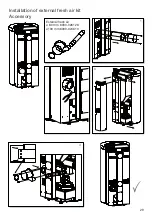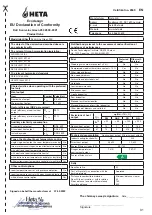
20
Wood pellets
Most people do not experience problems when
they fire with wood pellets. Wood pellets are
easy to use and modern pellet stoves are extre-
mely user-friendly. Normally there is little need
for repeated annual inspections, and you will
quickly discover that the pellet stove takes care
of itself most of the time.
Should you, however, experience problems with
the pellet stove, you can almost always be cer-
tain that they are due either to the settings and/
or the installation of the pellet stove or the qua-
lity of the wood pellets used. Using an inferior
quality wood pellet will automatically lead to
greater ash production, which can have a nega-
tive impact on the efficiency of the pellet stove.
EFFECTIVE CALORIFIC VALUE OF WOOD
PELLETS
When determining the quality of your wood pel-
let, take a look at its effective calorific value. The
effective calorific value is an expression of the
amount of energy that a wood pellet can deliver
and is determined by the content of water and
ash in the wood. The best wood pellet contains
a maximum of 0.4% ash and a maximum of 7%
water. At these percentages, a wood pellet deli-
vers 4.9 kWh/kg.
WOOD PELLET CHEMISTRY
Wood pellets are basically compressed wood
which, when burned, produce energy that can
be used to heat your home. However, as can be
seen from the above, it is important that you pay
attention to the content of the various compo-
nents of the wood pellet and to how it behaves
under the circumstances to which it is exposed
when burned.
WATER CONTENT
Water is a natural part of wood. And, as pre-
viously mentioned, the content of water directly
affects the efficient calorific value. When the
wood pellet is burned, water evaporation occurs.
If the water content is very high, it will negatively
impact the energy level, just as you risk more
ash build-up inside the chimney. However, wa-
ter is a necessary component of the wood pel-
let, as moisture helps to ensure a durable pellet
and prevent dust. Choose a moisture content of
6-8% for the best result.
ASH CONTENT
When you burn wood pellets, a residue will oc-
cur in the form of ash. Here, of course, you want
to select a wood pellet that produces as little
ash as possible. There is a big difference in the
amount of ash wood pellets produce. The best
pellets produce as little as 0.3%, while standard
pellets can produce as much as 5%. Bear in
mind that a high effective calorific value and a
low level of water result in the least ash content.
ASH MELTING POINT
It is very important to know the ash melting point
when avoiding clinker build-up in the pellet sto-
ve. Clinker is what happens when the ash from
the pellets clumps together and this process can
reduce the efficiency of the pellet stove. The-
refore, always pay attention to the ash melting
point of the pellets and choose a product where
the ash melting point is above 1,200oC.
DENSITY
The density of the wood pellet depends on how
hard it is pressed together. The harder the com-
pression, the smaller the pellet, which still pro-
duces the same amount of energy.
WOOD PELLET DURABILITY IS IMPORTANT
When you buy wood pellets, you will often buy
large quantities at a time. Both because it is che-
aper and because you need a lot of wood pellets
to meet your energy requirements. It is therefore
important that you think carefully about how to
store the pellets.
Pellets with poor mechanical durability break
during transport and can crumble. Here you
must select a wood pellet that has a strength of
97.5%. The figure here means that after trans-
port only 2.5% of the pellets will have been de-
stroyed.
Also bear in mind that the pellets are sensitive
to the elements. They must therefore always be
stored using appropriate packaging. That way
you can be sure that they remain free of mice,
rats or other vermin. Protect them from moisture
and store them indoors if possible.
Heta A/S recommends using Premium wood
pellets from Heatlets.dk to get the most out
of your pellet stove.













































